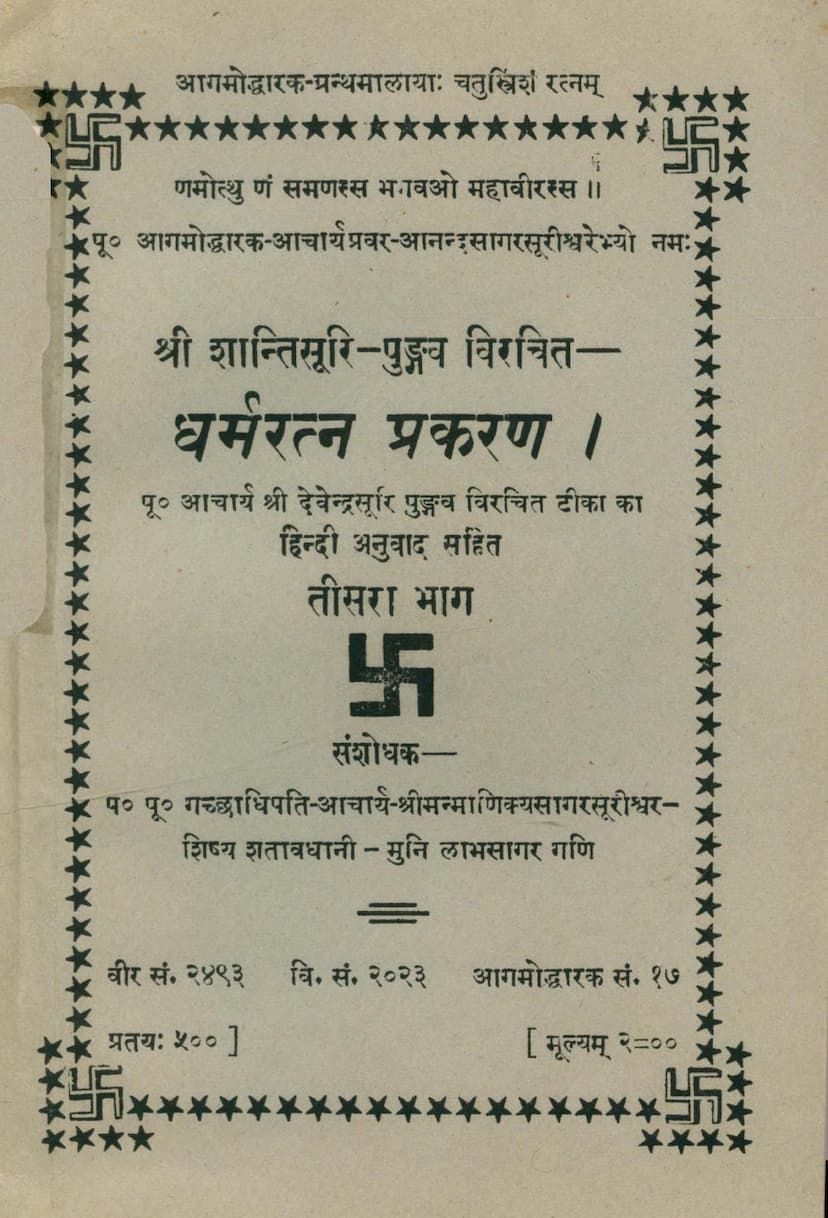Dharmratna Prakaran Part 03
Added to library: September 1, 2025

Summary
This is a comprehensive summary of "Dharmaratna Prakaran Part 03" by Acharya Shantisuri, with commentary by Acharya Devendrasuri, translated into Hindi, and researched by Muni Labhsagar Gani. The publisher is Agamoddharak Granthmala.
The book is the third part of a series aimed at explaining the "Dharmaratna Prakaran" (Treatise on the Jewel of Dharma) with a Hindi translation of the commentary. It focuses on the characteristics and conduct of a "Bhav-Sadhu" (a Sadhu in spirit and practice).
Key Themes and Content:
-
The Seven Marks of a Bhav-Sadhu: The core of this volume is the detailed exposition of seven key characteristics that define a true spiritual practitioner (Bhav-Sadhu). These are:
- Marganusarini Kriya (Conduct in Accordance with the Path): Following the principles laid down in the scriptures or the conduct of virtuous individuals.
- Pravara Shraddha (Supreme Faith): Deep devotion and aspiration towards Dharma (Jain teachings).
- Prajnapanitva (Being Teachable/Reasonable): Openness to understanding and avoiding biased or incorrect views.
- Kriyas mein Apramada (Diligence in Actions): Performing all actions with utmost care and without negligence.
- Shakyanushthanarambh (Undertaking Feasible Practices): Engaging in austerities and practices that are within one's capacity.
- Gunanurag (Affection for Virtues): Deep admiration and love for the qualities of the virtuous.
- Gurvadnyaradhan (Obedience to the Guru): Complete adherence to the teachings and commands of the spiritual preceptor.
-
Exemplary Narratives: Each of the seven marks is illustrated with stories and anecdotes from the lives of Jain saints and historical figures. These stories serve to clarify the abstract principles and make them relatable. Notable stories include:
- The conduct of Durlabhika Pushyamitra.
- The story of Aryamangu.
- The life of Acharya Achalamuni.
- The devotion of Sangamsuri.
- The teachings of Nirgrantha Muni to King Shrenik.
- The incident involving Shrutakirti and Shivbhakti.
- The exemplary devotion of Vajraswami.
- The story of King Sunanda.
- The life and conduct of Acharya Aryamahagiri.
- The story of Shivbhuti and his folly.
- The life of King Purushottam (Shrikrishna).
- The story of Shivbhadra Muni.
- The exemplary life of Shripurva Maharaja.
-
Detailed Explanations of Practices: The text elaborates on various Jain practices, including:
- The significance of following scripture-based actions.
- The importance of pure faith and the nuances of its expression.
- The process of understanding teachings and avoiding misconceptions.
- The need for mindfulness and diligence in daily conduct.
- The wisdom in undertaking practices suited to one's strength.
- The virtue of appreciating the good qualities in others and acknowledging one's own faults.
- The paramount importance of guru devotion and obedience.
- The rules and regulations for monastic life, including acceptable and unacceptable conduct (upadhi).
- The process and significance of 'Pratikraman' (confession and repentance).
-
The Role of the Guru: A significant emphasis is placed on the Guru's role as the guide and source of true knowledge. The text details the qualities of an ideal Guru (listing 36 virtues) and the disciple's duty to respect, learn from, and serve them, even in challenging circumstances.
-
Distinguishing True from False Conduct: The book differentiates between genuine spiritual practice and superficial or misguided actions. It warns against the dangers of ego, pride, lack of adherence to scriptures, and following one's own whims instead of the Guru's guidance (as seen in the story of Shivbhuti).
-
The Concept of 'Jina-kalpa' and 'Sthavira-kalpa': The text touches upon different paths of asceticism, including the stricter 'Jina-kalpa' and the more adaptable 'Sthavira-kalpa', discussing their practices and the wisdom in choosing according to one's capabilities.
-
The Nature of the Soul and Liberation: It describes the state of the liberated soul (Siddha) and the ultimate goal of spiritual practice, which is Moksha (liberation). The analogy of the Mleccha (foreigner) unable to describe the city's beauty due to lack of comparable experience is used to illustrate the ineffable nature of the Bliss of Liberation.
-
The Essence of Dharma: The book ultimately aims to guide the reader towards understanding and practicing "Dharma" in its true essence, leading to spiritual well-being and liberation. It emphasizes that true Dharma is found in the consistent application of virtuous conduct, faith, wisdom, and devotion to the Guru and the path.
Overall Purpose:
"Dharmaratna Prakaran Part 03" serves as a guide for aspiring Jain ascetics and devout laypersons. It provides a practical framework for understanding and embodying the core principles of Jainism, particularly the path of a true spiritual aspirant, by illustrating these principles through the lives and teachings of revered figures. The meticulous explanation and illustrative stories aim to inspire and educate the reader, leading them towards spiritual progress and the ultimate goal of liberation.